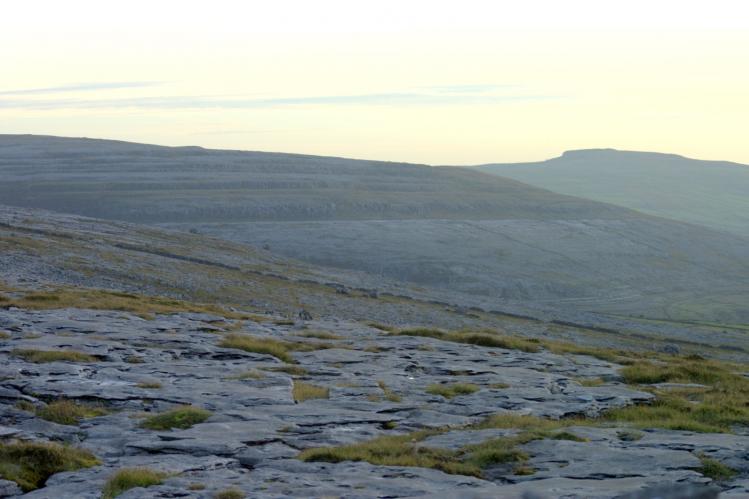
Across the Burren I climbed, through the morning’s gray west-of-Ireland drizzle. With half-a-dozen fellow pilgrims and a guide named Pius, I was making my way toward the holy well of a sixth-century saint called Colman mac Duagh. In my pocket was a jagged little stone I’d picked up by the gate, but I’m pretty sure I’d been carrying it with me for a long time.
“Choose a rock with sharp edges,” Pius said. That was easy: everything in the Burren is craggy and sharp. Before the Celts, before the Druids, before Patrick, people lived in this godforsaken place and, somehow, eked out a life. They dwelt in caves that are still there—we crouched into one known as St. Colman’s Bed, wondering at the loneliness and peace and terrible beauty he must have known.
I think it may have been the place I was looking for, too, or at least the place I needed to be. As we trudged across slabs of limestone and shale, Pius told us, “Slide your hand in your pocket; finger your jagged stone while you think about the jagged stone in your life. Consider the thing that irritates you, confounds you, frustrates you, holds you back. And while you’re doing that, as you walk across the Burren, pay attention to everything. Watch and listen.”
Easy, I thought. There’s nothing much to notice. There were only rocks, and crevices, and, inside those crevices, dry dirt. No animals scurrying by, except for the snails. Snails were everywhere. Birds, too, flitting in the quiet, from rock to rock. And flowers: Pius told us that in the spring, this barren moonscape is awash with wildflowers, gentians and marsh orchids and mountain avens and a thousand others. Even now, at the beginning of October, there were weedy, scrappy plants popping out from the grikes, the crevices that split this giant expanse of rock into pieces. It was so quiet, I think I heard my heart beating, my pulse throbbing, slow and steady. I noticed and watched and listened, and thumbed the jagged stone in my pocket.
That stone was my daughter-in-law, once beloved, now caught up in a swirling maelstrom of a marriage that ended but still seems to linger on. It was the years of misunderstandings, and the tears shed for Katy, the little girl the marriage had produced. It was fear and dread over what would become of the child, and frustration over my inability to do anything about it. It was long nights of anxiety. It was sorrow for my first-born son; my heart was aching for his broken heart.
My fellow pilgrims in the Burren had stones in their pockets, too, and heartaches of their own. So on we all trudged. Far off in the distance there were sheep grazing, like there are everywhere in the west of Ireland, and even a scattering of feral goats. But here, at our destination, there was a quiet little copse, with some shrubby trees and bushes. There was the dank, wet cave that Saint Colman lived in for seven years, and the altar, in the open air, where he said Mass. The ground was slippery now; there were fewer rocks, more vegetation, more mud. Climbing the final steps took utter concentration, and everyone’s shoes and clothes were caked in black Irish soil. Hanging on to branches and sliding precariously on rocks, Pius took us back to the holy well where St. Colman drank and bathed and baptized the pilgrims who came up here into the wilderness to seek the same thing all of us were seeking.
Gathered around the well, a gurgling pool of cold, clear water streaming down the mountain to this secluded place, we stood quietly and listened. “Take your stone,” said Pius. “Take your worries and your fears and your anxieties, and cast them into the well.” So in they plopped, one by one. We scooped up handfuls of water, each of us, and blessed one another with it.
Long before Patrick ever set foot in Ireland, the pagan Celts believed their island was a thin place, a holy place, where the veil between heaven and earth, time and eternity, disappears. It seemed to disappear that gray morning as we headed back, silent and unburdened. My pocket was empty. The stone was gone, and my worries disappeared, too, at least for a while. I prayed prayers of gratitude. I prayed for my ex-daughter-in-law, and for my son, and for their child. I prayed for healing. I think all of us prayed for healing—washed in the waters of Colman mac Duagh’s holy well.
Please email comments to [email protected] and join the conversation on our Facebook page.
Share
Previous Story
Narrative Shreds
Next Story
Time to Listen